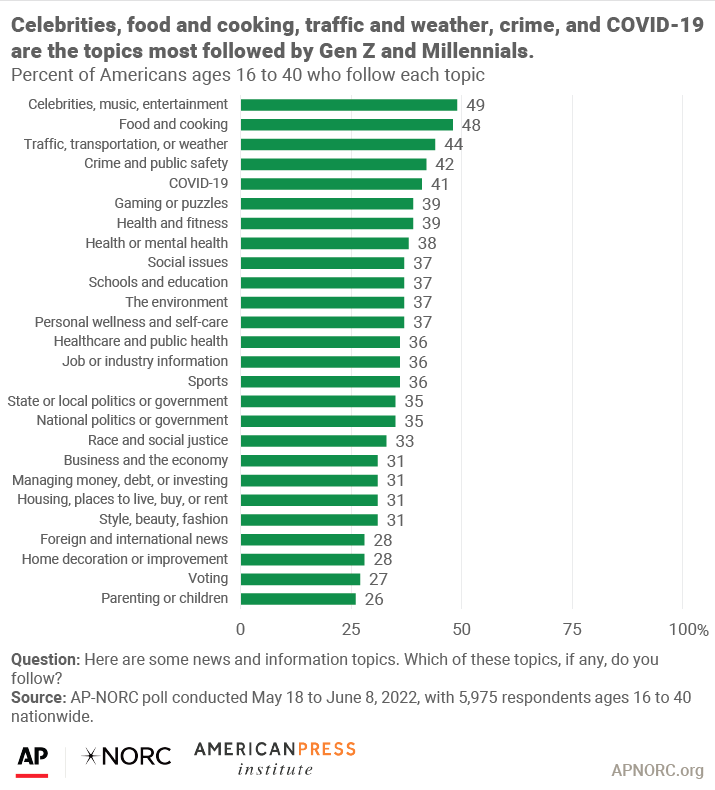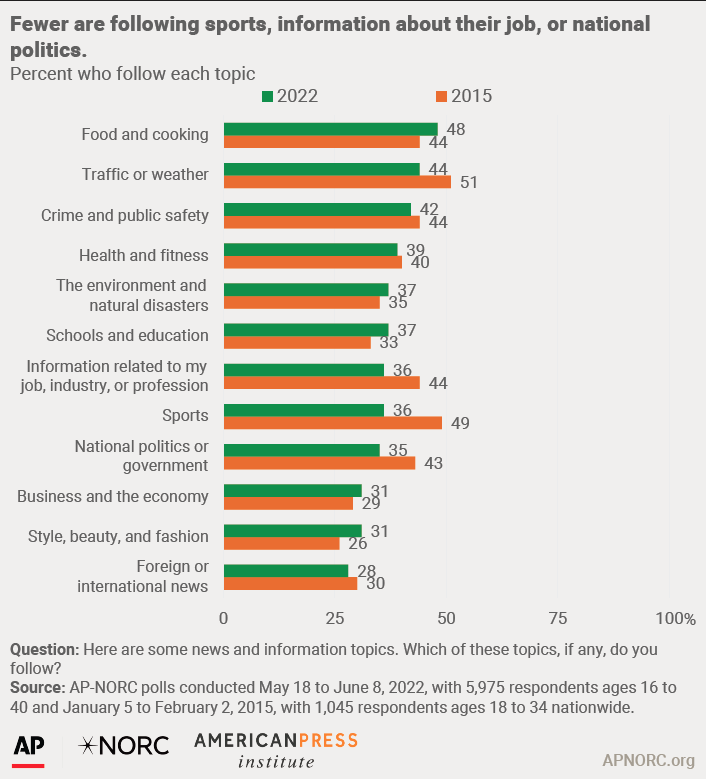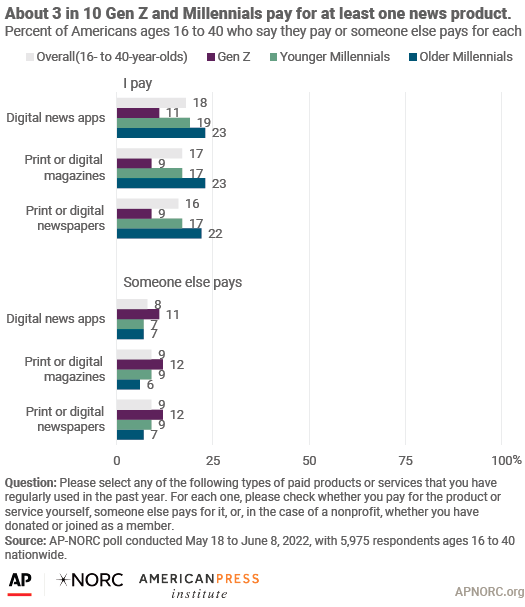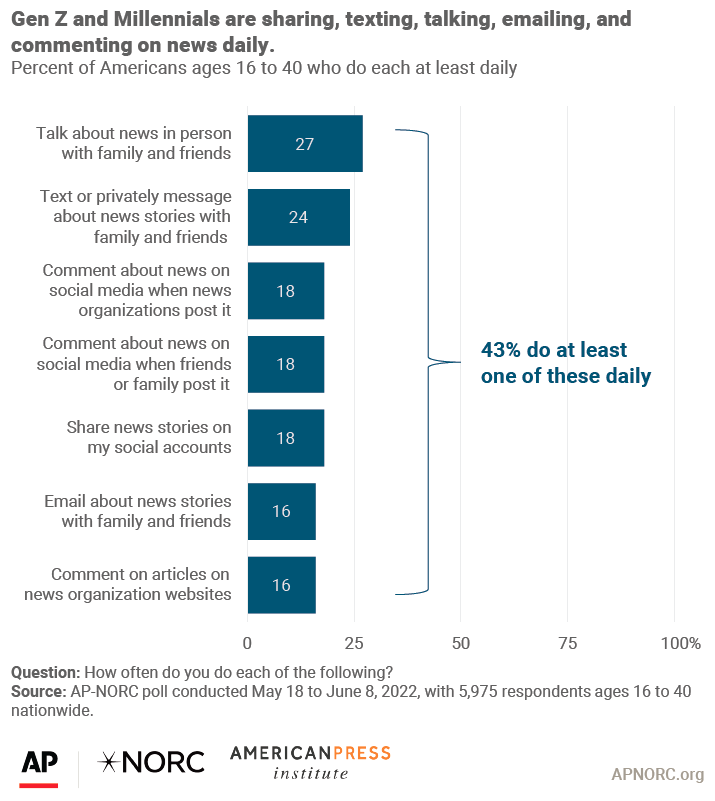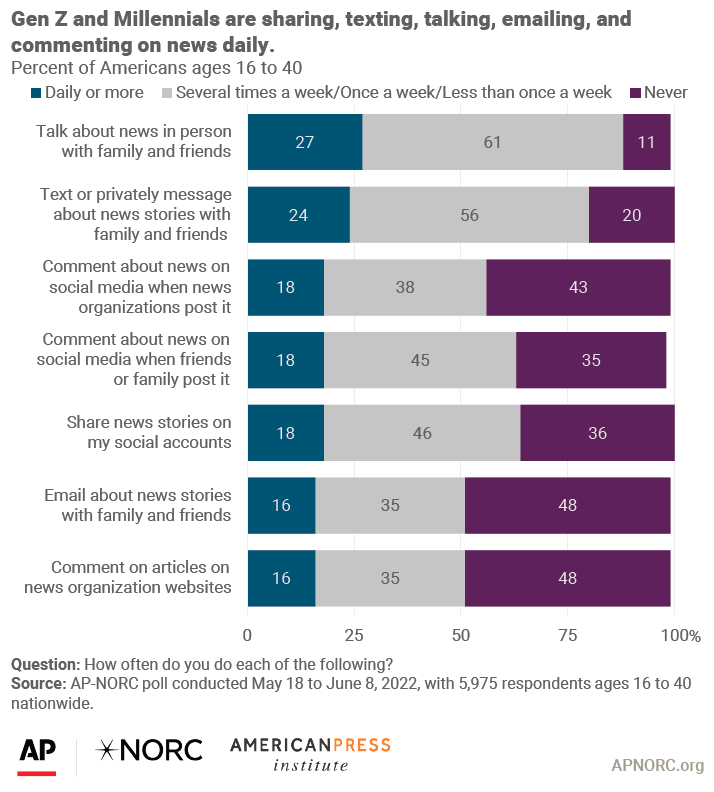Gen Z and Millennials use a variety of media to get news
Even with signs of fatigue and worry about being online, Americans ages 16 to 40 are avid news consumers, getting news from many different sources.
The vast majority of Gen Z and Millennials get news daily (79%). Fully 96% report doing so at least weekly.
Gen Z and Millennials, moreover, consume news from a wide range of sources. That mix includes traditional national and local news outlets such as newspapers, TV news stations, their websites, or apps. It also includes a wide range of social media platforms — including Facebook, YouTube, Instagram, TikTok, Snapchat, Twitter, Reddit, LinkedIn, Twitch, and Nextdoor. Indeed, on average, those surveyed consume news from about six different traditional sources or social media platforms at least weekly.
These generations still rely heavily on traditional sources. Fully 74% of Gen Z and Millennials consume news and information at least weekly from traditional outlets; 45% do so daily. The average 16- to 40-year-old consumes news from about two different traditional news outlets at least weekly.[ref Average number of traditional (local or national news outlets, newspapers, TV news stations, their websites, or apps) and social media (Facebook, Twitter, Instagram, Snapchat, TikTok, Twitch, YouTube, LinkedIn, Reddit, or Nextdoor) sources used at least weekly to get news or information.]
Older Millennials are more likely to rely on traditional news sources than younger Millennials and Gen Z. Forty-four percent of Gen Z report never receiving news and information from traditional sources compared with 35% of younger Millennials and 31% of older Millennials.
Gen Z and Millennials use local and national news with similar frequency
The study suggests that local news is still an important part of the information diet of Americans ages 16 to 40. Gen Z and Millennials consume local sources just as frequently as national sources; 67% report consuming news from both local and national sources at least weekly; 37% do so daily.
Social media platforms prevail over traditional sources among Gen Z and Millennials
For all this use of traditional news sources, however, Gen Z and Millennials are still more likely to get news and information more frequently from social media including Facebook, YouTube, Instagram, TikTok, Snapchat, Twitter, Reddit, LinkedIn, Twitch, and Nextdoor. Indeed, 71% get news from social media platforms at least daily and 91% at least weekly. On average, they consume news from about four social media platforms at least weekly.
Gen Z is especially likely to get news daily on social media platforms when compared with older Millennials (74% compared with 68% for older Millennials).

Facebook, YouTube, and Instagram are the social media platforms used most frequently for news. But the use of social media platforms for news varies among the age groups. Members of Gen Z are less likely to report getting news and information from Facebook daily compared with Millennials. In all, 32% of Gen Z say they get news from Facebook daily. That compares with 43% of younger Millennials and 45% of older Millennials. Instead, members of Gen Z are more likely to get news from Instagram, with fully 39% getting news daily from Instagram compared with 33% of younger Millennials and 29% of older Millennials. Members of Gen Z are also more likely than younger Millennials and older Millennials to rely on TikTok for news (40% vs. 27% and 21%) and on Snapchat (32% vs. 22% and 17%).
Comparing the new results to 2015
These numbers represent a decline for Facebook and a turn to other social platforms. Overall, 40% of 16- to 40-year-olds in 2022 are using Facebook daily for news compared with 57% in 2015. However, more are using Instagram, YouTube, Twitter, and Reddit.
In 2015, 61% of younger Millennials (who were 18 to 24 years old then) used Facebook daily compared with only 43% who say the same now as 25- to 31-year-olds. The youngest generations surveyed in 2015 and 2022 also differ. In 2022, just 32% of Gen Z (16- to 24-year-olds) use Facebook daily for news compared with 61% of younger Millennials in 2015.
Lifestyle, hard news, and news you can use topics
One way the Media Insight Project has probed news consumption among younger Americans is to query people on where and how they get news and information on different topics, rather than asking about news in general. This approach helps avoid the problem that some respondents might define news differently than others. We also ask about the sources they use to get news and information. This allows us to understand how people may use social media as a pathway to news.
As we found in 2015, the 2022 survey shows that Gen Z and Millennials follow news on a wide range of topics. To get at this, the survey asks about 29 separate topics. We then group those topics into three categories. The “hard news” category includes such topics as government or politics, the economy, and crime and public safety. “News you can use” includes such topics as COVID-19 information, elections and voting information, traffic, transportation, and weather. “Lifestyle news” includes such topics as celebrities and entertainment, food and cooking, and health and fitness.
On average, Gen Z and Millennials follow about nine different news or information topics out of the 29 asked on the survey.
They also tend to follow a similar number of “lifestyle” topics (3 out of 9), as well as “news you can use” topics (3 out of 9), and” hard news” topics (4 out of 11). These findings basically remain unchanged from 2015, when they followed an average of 9.5 topics overall and four “hard news” topics.
The most-followed topic among Gen Z and Millennials is news and information related to celebrities, music, TV, movies, or entertainment. About half (49%) say they follow that topic regularly and 48% follow food and cooking. About 4 in 10 say they follow topics such as traffic, transportation, or weather, crime and public safety, and news about COVID-19.
The chart below shows all 29 topics. At the bottom of the list, though still followed by sizable minorities, are foreign or international news, home decoration or improvement, information on voting, or information related to children or parenting.
Comparing the new results to 2015
Some of these numbers diverge compared with what we found in 2015. For instance, fewer Gen Z and Millennials report following sports than did seven years ago. Fewer report following news about their job or profession, and national politics and government now than seven years ago.[ref These findings are also significant when restricting the 2022 sample to ages 18 to 34, the same age range as the 2015 sample.]
Gen Z and Millennials continue to actively seek out news
One of the key findings of our study of Millennials seven years ago was comparing the behavior of people we dubbed news “Seekers” versus “Bumpers.” Seekers are people who say that on balance they actively seek news they follow. Bumpers are people who say on balance they let the news find them.
Overall, we find the mix of Bumpers and Seekers among Gen Z and Millennials has not changed in the last seven years, despite the proliferation of social media platforms.
In all, 38% of Gen Z and Millennials say they actively seek news; 61% say they mostly bump into it. This is nearly identical to Millennials in 2015, when 39% said they actively seek news.
With age, people are more likely to actively seek the news — 44% of older Millennials and 40% of younger Millennials say they seek news, compared with just 29% of Gen Z.
Gen Z and Millennials pay for and donate to news services
One critical question for the news industry is whether younger news consumers are willing to pay for news. With the maturation of the web, advertising revenue has dramatically shifted from news organizations (where it underwrote journalism) to digital platforms that do not employ traditional journalists or produce their own news content. Meta (Facebook) and Alphabet (Google) by themselves control close to two-thirds of all digital advertising revenue.[ref https://www.cnbc.com/2022/08/03/amazon-online-advertising-meta-twitter-snap-and-pinterest.html] To survive, news organizations increasingly must diversify their revenue, for example relying more on subscriptions, donors, and members, for revenue.
In all, 28% of Gen Z and Millennials say they pay for at least one news product such as print or digital magazines, print or digital newspapers, and digital news apps. This includes 18% of Gen Z, 30% of young Millennials, and 36% of older Millennials. Another 18% report someone else paying for at least one of these products, including 23% of Gen Z, 17% of young Millennials, and 16% of older Millennials.
Those numbers are similar to what we found seven years earlier. In 2015, 30% of Millennials said they paid for a subscription to a product such as a print or digital magazine, print or digital newspaper, or a digital news app.
One growing trend in journalism is the launch of nonprofit news sites and the rise of independent creators (who are not necessarily nonprofit). This news sector was once largely limited to public radio and television. Today, there are hundreds of nonprofit news operations and news platforms from independent creators relying on contributions from members and foundations. How popular are these sites among Gen Z and Millennials who pay for news?
The numbers suggest nonprofit sites, independent creators, and public radio and TV have become an important part of news consumption of these generations. In all, 25% of Gen Z and Millennials have become a member or have donated to at least one of these news operations. This includes 26% of Gen Z, 22% of younger Millennials, and 25% of older Millennials.
Gen Z and Millennials share, text, talk about, email, or comment on news daily, but that behavior is declining
Another important issue facing the news industry is how people use the news they get. Understanding this is a key factor for news organizations to create products that have sufficient value for consumers to be willing to pay for them.
The survey finds that Gen Z and Millennials use news in a variety of ways, but many of these numbers appear to also be slipping from seven years ago.
Nearly half (43%) of Gen Z and Millennials engage with the news through sharing, texting, emailing, or commenting at least once a day.
They are more likely to engage directly with family and friends rather than engage with news online or through social media accounts. Forty percent of Gen Z and Millennials either text, share, comment, or talk about news with family and friends at least once per day while only 27% do the same with other social media accounts or news organizations’ websites at least once a day.
Continue reading: News and digital fatigue
Share with your network
The news habits and attitutes of the Gen Z and Millennial generations
You also might be interested in:
As the economics of journalism continue to evolve, a defining question about the future is whether the news media can create content that consumers are willing to pay for or donate to directly. Central to answering that question is understanding the behavior of what many publishers call the next generation of news audiences: Millennials and Gen Z. This report examines in detail who among these audiences pay for or donate to news, how these payers or donors get news, and what topics or interests drive that behavior.
A summary of API's Inclusion Index work in Pittsburgh, starting with the cohort’s inclusion scores and ending with recommendations for effective ways they can work as a whole to improve the Pittsburgh media ecosystem.





